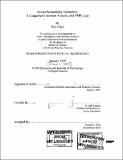In-situ permeability estimation : a comparison between acoustic and NMR logs
Author(s)
Chen, Wei
DownloadFull printable version (6.136Mb)
Alternative title
In-situ permeability estimation : a comparison between acoustic and nuclear magnetic resonance logs
Other Contributors
Massachusetts Institute of Technology. Dept. of Earth, Atmospheric, and Planetary Sciences.
Advisor
M. Nafi Toksöz.
Terms of use
Metadata
Show full item recordAbstract
The estimation of formation permeability from full waveform acoustic and nuclear magnetic resonance (NMR) logs in petroleum well logging has improved significantly in recent years. In this thesis, we review the methods of permeability estimation from Stoneley waves and provide permeability comparisons between acoustic and NMR logs. When a Stoneley wave travels along a permeable formation, hydraulic exchange between the Stoneley wave and formation will occur. As a result, Stoneley wave travel time will be delayed and the Stoneley wave attenuation will increase, causing a centroid frequency shift. Therefore, these two wave attributes can be used to estimate formation permeability. NMR logging data can also be used to estimate permeability. Permeability estimates using Stoneley waves and NMR logging were tested using data from a section consisting of sandstone and shale beds. The permeability results show very good correlation for these two different methods. Data from a gas zone that is analyzed shows high permeability values from acoustic data and low values from NMR. The difference between these two permeability results can be used as a gas zone indicator.
Description
Thesis (S.M.)--Massachusetts Institute of Technology, Dept. of Earth, Atmospheric, and Planetary Sciences, 1999. Includes bibliographical references (leaves 41-45).
Date issued
1999Department
Massachusetts Institute of Technology. Department of Earth, Atmospheric, and Planetary SciencesPublisher
Massachusetts Institute of Technology
Keywords
Earth, Atmospheric, and Planetary Sciences.